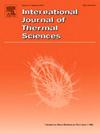自然对流条件下分支辐射式散热片的最佳管肋间距
IF 4.9
2区 工程技术
Q1 ENGINEERING, MECHANICAL
International Journal of Thermal Sciences
Pub Date : 2025-05-10
DOI:10.1016/j.ijthermalsci.2025.109973
引用次数: 0
摘要
由于散热效率低下,发光二极管(led)的性能在高温下显着下降。被动散热器,如散热片,是管理led产生的热量的有效解决方案。翅片的设计对于确保高散热率以及较低的质量至关重要。本文对自然对流条件下带分支针翅的径向散热器进行了数值研究。主要目标是获得分支针翅的优化设计。对翅片高度(15mm <H<)的影响进行了参数化研究。30 mm)、翅片数(5<n<20)和引脚翅片间距(2mm<Ls<10mm)对散热器阵列换热性能的影响。采用基于热阻和散热器质量的传热增强系数来计算当前设计的分支板翅径向散热器的传热性能增加。由于采用了分支针翅,当翅片高度为15毫米和30毫米时,散热器的质量降低了23% - 33%,同时提供了与分支板翅散热器相似的散热性能。从目前的研究来看,对于n>;20和H=21.3 mm的鳍阵列,最佳的引脚鳍间距为4 mm时,其质量和热阻最低。本文章由计算机程序翻译,如有差异,请以英文原文为准。
Optimum pin-fin spacing of branching radial heat sinks under natural convection for LED cooling
The performance of Light Emitting Diodes (LEDs) experiences a significant degradation at elevated temperatures due to inefficient heat dissipation. Passive heat sinks, such as fins, are an effective solution for managing the heat generated by LEDs. The design of fins is critical for ensuring high rates of heat removal as well as lower mass. This study conducts a numerical investigation of radial heat sinks with branching pin fins under natural convection. The primary objective is to obtain an optimum design of the branching pin fins. A parametric study is conducted to observe the effect of fin height (15 mm 30 mm), fin number (), and pin-fin spacing () on the heat transfer performance of the heat sink arrays. A heat transfer enhancement factor based on the thermal resistance and mass of the heat sink is used to calculate the increase in the heat transfer performance of the current design over the branching plate fin radial heat sinks. Due to the branching pin fins, the mass of the heat sinks reduces by 23 %–33 % for fin heights of 15 mm and 30 mm while providing similar thermal performance as branching plate-fin heat sinks. From the current study, an optimum pin-fin spacing of 4 mm yields the lowest mass and thermal resistance among the other pin fin-spacings for fin arrays with and mm.
求助全文
通过发布文献求助,成功后即可免费获取论文全文。
去求助
来源期刊

International Journal of Thermal Sciences
工程技术-工程:机械
CiteScore
8.10
自引率
11.10%
发文量
531
审稿时长
55 days
期刊介绍:
The International Journal of Thermal Sciences is a journal devoted to the publication of fundamental studies on the physics of transfer processes in general, with an emphasis on thermal aspects and also applied research on various processes, energy systems and the environment. Articles are published in English and French, and are subject to peer review.
The fundamental subjects considered within the scope of the journal are:
* Heat and relevant mass transfer at all scales (nano, micro and macro) and in all types of material (heterogeneous, composites, biological,...) and fluid flow
* Forced, natural or mixed convection in reactive or non-reactive media
* Single or multi–phase fluid flow with or without phase change
* Near–and far–field radiative heat transfer
* Combined modes of heat transfer in complex systems (for example, plasmas, biological, geological,...)
* Multiscale modelling
The applied research topics include:
* Heat exchangers, heat pipes, cooling processes
* Transport phenomena taking place in industrial processes (chemical, food and agricultural, metallurgical, space and aeronautical, automobile industries)
* Nano–and micro–technology for energy, space, biosystems and devices
* Heat transport analysis in advanced systems
* Impact of energy–related processes on environment, and emerging energy systems
The study of thermophysical properties of materials and fluids, thermal measurement techniques, inverse methods, and the developments of experimental methods are within the scope of the International Journal of Thermal Sciences which also covers the modelling, and numerical methods applied to thermal transfer.
 求助内容:
求助内容: 应助结果提醒方式:
应助结果提醒方式:


